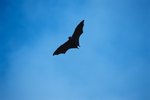Within the United States there are 19 species of owls that are found year-round, where several of these species can be found within the eastern part of Texas. Owls are nocturnal birds and skilled hunters of small mammals, lizards, frogs and even other birds. Owls come in a variety of sizes, colors, with also different eating and living habits. For instance, while most owls live in trees, there are owls such as the Burrowing Owl which live predominantly underground.
Barred Owl
The Barred Owls is a gray-brown colored medium-sized owl, streaked with white horizontal bars on its chest and vertical bars on its belly. They tend to hide in dense foliage, high above the ground during the day. Even though barred owls are nocturnal, it is not uncommon to see one during the day. Barred owls do not move from their territory their entire lives and are protected by state of Texas and federal laws. These birds are known for their wide range of vocalizations. Its main prey include meadow voles, shrews and deer mice, but will prey on other small species as well.
Burrowing Owl
The Burrowing Owl is small with a round head, no ear tufts and long legs. They feature a sandy color on their head, back and the upper parts of their wings. They are relatively easy to site because they are active during the day and allow individuals to get within a close proximity before taking flight. While they live predominantly underground, they are mostly seen around dusk and dawn, and can be seen perched on a mound of dirt or a fence post. The burrowing owl’s diet changes depending on the time of year, but it mostly consists of beetles, grasshoppers and small mammals.
Great Horned Owl
This species is commonly found throughout the U.S., including eastern Texas. The Great Horned Owl varies in color, from reddish brown to grey or black and white. They have very large yellow-orange eyes that peer out from a face bordered by an orange-buff facial disc. Their name comes from the tufts of feathers that appear to be horns, but are actually ear tufts. While they are mostly active during the night, they can also be seen active in the late afternoon or early morning. This owl is known to be aggressive if approached when nesting. They hunt by diving to the ground to catch its prey, walking on the ground and even wading into water to catch frogs and fish. They prey on a variety of species, most notably are rodents, squirrels, mink, skunks, raccoons, armadillos, porcupines, shrews, moles, muskrats and bats.
Eastern Screech Owl
Eastern Screech Owls can be found in two different color varieties, the gray phase and reddish-brown phase. They live in mixed woodlands, deciduous forests, park lands, wooded suburban areas, and the woods along streams and wetlands. They avoid dense and elevated forests. When it feels threatened, it will stretch its body and flatten its feathers against its body in order to resemble a branch stub. However, if it feels it has been seen then it will fly. Their main favorite prey are small microtine rodents and deer mice, but other prey includes Norway rats, chipmunks, cotton rats, squirrels, shrews, bats and moles.
References
Photo Credits
-
Owl image by Moyra Miller from Fotolia.com
Writer Bio
Carrieanne Larmore has been a professional writer since 2004, mainly writing marketing studies, business plans and research papers. She has held management and executive positions in multimillion-dollar corporations within the United States and Canada, created the E-Commerce Business Journal, and founded Royal Summit Consulting Inc. Larmore holds a Master of Business Administration in entrepreneurship, plus a bachelor's degree in finance and management.




